sensor HONDA CR-V 2007 RD1-RD5, RE7 / 3.G Owners Manual
[x] Cancel search | Manufacturer: HONDA, Model Year: 2007, Model line: CR-V, Model: HONDA CR-V 2007 RD1-RD5, RE7 / 3.GPages: 352, PDF Size: 5.77 MB
Page 22 of 352

Your seat belt system includes lap/
shoulder belts in all five seating
positions. The front seat belts are
also equipped with automatic seat
belt tensioners.
This system uses the same sensors
as the front airbags to monitor
whether the front seat belts are
latched or unlatch ed, and how much
weight is on the front passenger’s
seat (see pages and ). If the indicator comes on or the
beeper sounds when the driver’s seat
belt is latched and there is no f ront
seat passenger and no items on the
front seat, something may be
interf ering with the monitoring
system. Look f or and remove:
Any items under the f ront
passenger’s seat.
Any objects hanging on the seat or
in the seat-back pocket.
Any objects, such as a f olded-down
back seat, that are touching the
rear of the seat-back.
If no obstructions are f ound, have
your vehicle checked by a dealer.
This system monitors the f ront seat
belts. If you turn the ignition switch
to the ON (II) position bef ore your
seat belt is f astened, the beeper will
sound and the indicator will f lash. If
your seat belt is not f astened bef ore the beeper stops, the indicator will
stop f lashing but remain on.
If a f ront passenger does not f asten
their seat belt, the indicator will
come on about 6 seconds af ter the
ignition switch is turned to the ON
(II) position.
If either the driver or a f ront
passenger does not f asten their seat
belt while driving, the beeper will
sound and the indicator will f lash
again at regular intervals.
When no one is sitting in the f ront
passenger’s seat, or a child or small
adult is riding there, the indicator
should not come on and the beeper
should not sound.
The seat belt system
includes an indicator on the
instrument panel and a beeper to
remind you and your passengers to
f asten your seat belts. 27 28
Seat Belt System Components
Additional Inf ormation About Your Seat Belts
18
Page 24 of 352
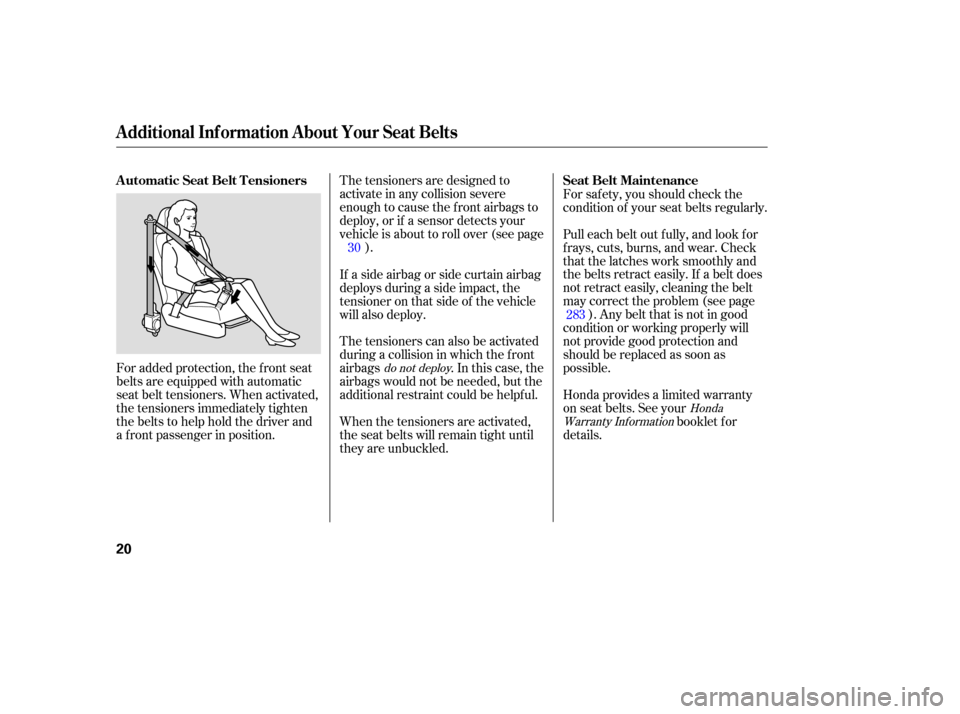
For added protection, the front seat
belts are equipped with automatic
seat belt tensioners. When activated,
the tensioners immediately tighten
the belts to help hold the driver and
a front passenger in position. The
tensioners are designed to
activate in any collision severe
enough to cause the front airbags to
deploy, or if a sensor detects your
vehicle is about to roll over (see page
).
The tensioners can also be activated
during a collision in which the front
airbags . In this case, the
airbags would not be needed, but the
additional restraint could be helpful.
When the tensioners are activated,
the seat belts will remain tight until
th ey are unbuckl ed. For
safety, you should check the
condition of your seat belts regularly.
Pull each belt out fully, and look for
frays, cuts, burns, and wear. Check
that the latches work smoothly and
the belts retract easily. If a belt does
not retract easily, cleaning the belt
may correct the problem (see page ). Any belt that is not in good
condition or working properly will
not provide good protection and
should be replaced as soon as
possible.
Honda provides a limited warranty
on seat belts. See your booklet f or
details.
If a side airbag or side curtain airbag
deploys during a side impact, the
tensioner on that side of the vehicle
will also deploy.
30
283do not deploy Honda
Warranty Inf ormation
A utomatic Seat Belt T ensioners Seat Belt Maintenance
Additional Inf ormation About Your Seat Belts
20
Page 26 of 352

A irbag System Components
Additional Inf ormation About Your Airbags
22
(1)(2)
(3)
(4)(5)
(6) (5)
(4)
(12)
(8)
(11)(10)
(7)
(13)
(9)
(1) Driver’s Front Airbag
(2) Passenger’s Front Airbag
(3) Control Unit/Rollover Sensor
(4) Front Seat Belt Tensioners
(5) Side Airbags
(6) Driver’s Seat Position Sensor
(7) Front Passenger’s Weight Sensors
(8) Passenger Airbag Off Indicator
(9) Side Impact Sensors (First)
(10) Occupant Position Detection System (OPDS) Sensors
(11) Front Passenger’s Weight Sensor Unit/OPDS Sensors Control Unit
(12) SRS Indicator
(13) Seat Belt Buckle Tensioners
Page 27 of 352
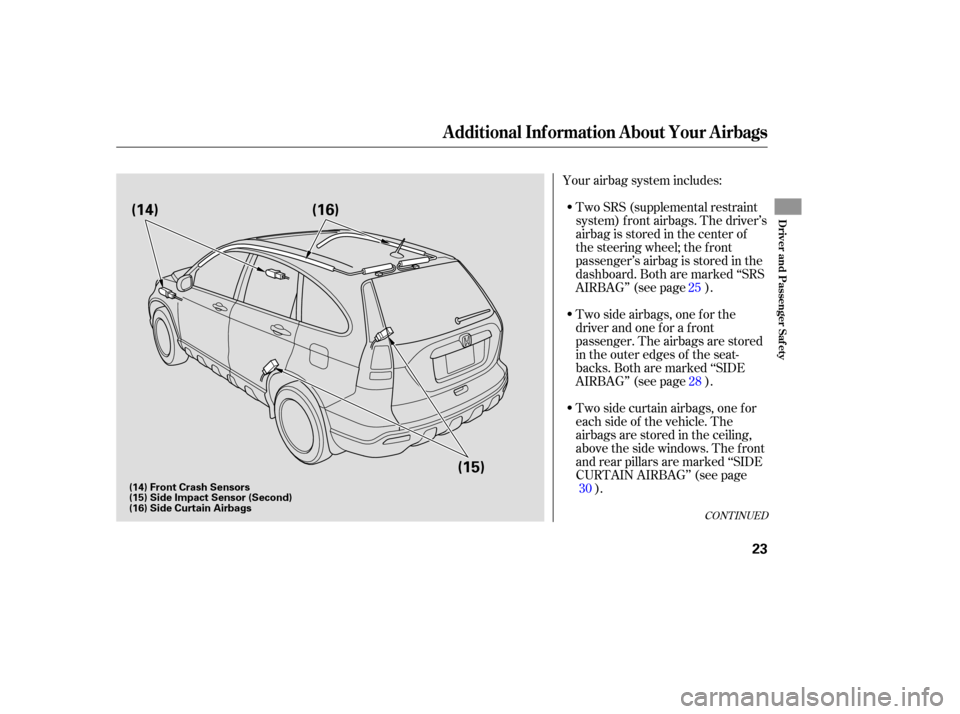
Your airbag system includes:
Two SRS (supplemental restraint
system) front airbags. The driver’s
airbag is stored in the center of
the steering wheel; the front
passenger’sairbagisstoredinthe
dashboard. Both are marked ‘‘SRS
AIRBAG’’ (see page ).
Two side airbags, one for the
driver and one for a front
passenger. The airbags are stored
in the outer edges of the seat-
ba cks. Both are marked ‘‘SIDE
AIRBAG’’ (see page ).
Two side curtain airbags, one for
each side of the vehicle. The
airbags are stor ed in the ceiling,
above the side windows. The front
and rear pillars are marked ‘‘SIDE
CURTAIN AIRBAG’’ (see page ). 25
28
30
CONT INUED
Additional Inf ormation About Your Airbags
Driver and Passenger Saf ety
23
(14) (16)
(15)
(14) Front Crash Sensors
(15) Side Impact Sensor (Second)
(16) Side Curtain Airbags
Page 28 of 352

Automatic front seat belt
tensioners (see page ).
Sensors that can detect whether a
child is in the passenger’s side
airbag path and signal the control
unit to turn the airb ag off (see
page ).
A driver’s seat position sensor that
monitors the distance of the seat
from the front airbag. If the seat is
too far forward, the airbag will
inflate with less force (see page
).
Weight sensors that monitor the
weight on the front passenger’s
seat. If the weight is about 65 lbs
(29 kg) or less (the weight of an
infant or sm all child), the
passenger’s front airbag will be turned
off (see page ).
Sensors that can detect whether
the driver’s seat belt and a front
passenger’s seat belt is latched or
unlatch ed (see page ).
A sophisticated electronic system
that continually monitors and
reco rds information about the
sensors, the control unit, the
airbag activators, the seat belt
tensioners, and driver and front
passenger seat belt use when the
ignition switch is in the ON (II)
position.
An indicator on the instrument
panel that alerts you to a possible
problem with your airbags,
sensors, or seat belt tensioners
(see page ). A
rollover sensor that can detect if
your vehicle is about to roll over
and signal the control unit to
deploy both side curtain airbags
and front seat belt tensioners (see
page ).
An indicator on the instrument
panel that alerts you that the
passenger’s side airbag has been
turned off (see page ).
An indicator on the dashboard that
alerts you that the passenger’s
front airbag has been turned off
(see page ).
Emergency backup power in case
your vehicle’s electrical system is
disconnected in a crash.
Sensors that can detect a
moderate to severe front impact,
side impact, or if your vehicle is
about to rollover.
27
20
29
27 18
31 31
32
30
Additional Inf ormation About Your Airbags
24
Page 29 of 352
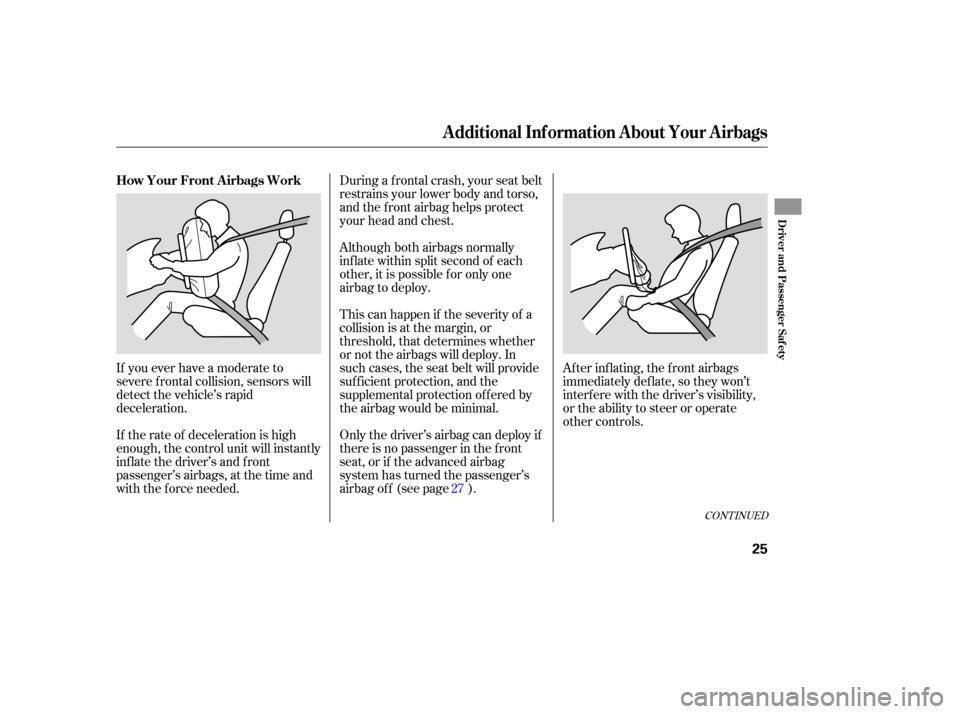
During a frontal crash, your seat belt
restrains your lower body and torso,
and the front airbag helps protect
your head and chest.
Al though both airbags normally
inflate within split second of each
other, it is possible for only one
airbag to deploy.
This can happen if the severity of a
collision is at the margin, or
threshold, that determines whether
or not the airb ags will deploy. In
such cases, the seat belt will provide
sufficient protection, and the
supplemental protection offered by
the airbag would be minimal.
If
you ever have a moderate to
severe frontal collision, sensors will
detect the vehicle’s rapid
deceleration.
If the rate of deceleration is high
enough, the control unit will instantly
infl ate the driver’s and front
passenger’s airbags, at the time and
with the force needed. Only
the driver’s airbag can deploy if
there is no passenger in the f ront
seat, or if the advanced airbag
system has turned the passenger’s
airbag off (see page ). Af ter inf lating, the f ront airbags
immediately def late, so they won’t
interf ere with the driver’s visibility,
or the ability to steer or operate
other controls.
27
CONT INUED
How Your Front Airbags Work
Additional Inf ormation About Your Airbags
Driver and Passenger Saf ety
25
Page 30 of 352

Your f ront airbags are also dual-
threshold airbags. Airbags with this
f eature have two deployment
thresholds that depend on whether
sensors detect the occupant is
wearing a seat belt or not.
If the occupant’s belt is ,
the airbag will deploy at a slightly
lower threshold, because the
occupant would need extra
protection.
If the occupant’s belt is , the
airbag will inf late at a slightly higher
threshold, when the airbag would be
needed to supplement the protection
provided by the seat belt.
Your f ront airbags are dual-stage
airbags. This means they have two
inf lation stages that can be ignited
sequentially or simultaneously,
depending on crash severity.
In a crash, both stages
will ignite simultaneously to provide
the quickest and greatest protection.
In a crash, one stage will
ignite first, then the second stage
will ignite a split second later. This
provides longer airbag inf lation time
with a little less force.
The total time for inflation and
def lation is one-tenth of a second, so
f ast that most occupants are not
aware that the airbags deployed until
they see them lying in their laps.
After a crash, you may see what
looks like smoke. This is actually
powder f rom the airbag’s surf ace.
Although the powder is not harmf ul,
people with respiratory problems
mayexperiencesometemporary
discomf ort. If this occurs, get out of
the vehicle as soon as it is saf e to do
so.
Dual-T hreshold A irbags
not lat chedlatched
Dual-Stage A irbags
more severeless severe
Additional Inf ormation About Your Airbags
26
Page 31 of 352
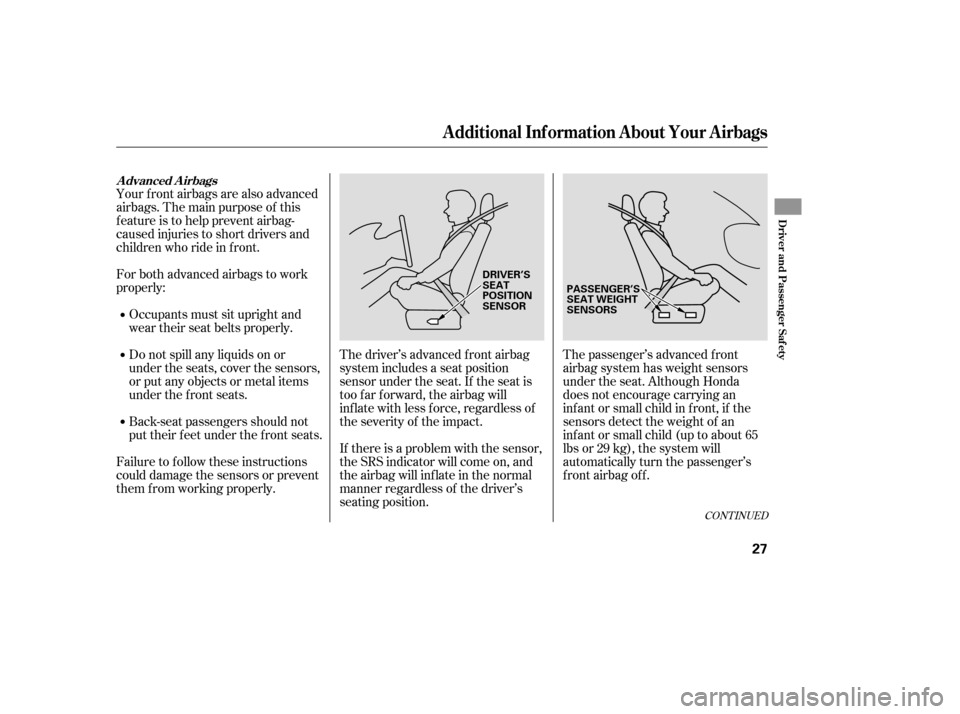
Your f ront airbags are also advanced
airbags. The main purpose of this
feature is to help prevent airbag-
caused injuries to short drivers and
children who ride in f ront.
For both advanced airbags to work
properly:Occupants must sit upright and
wear their seat belts properly.
Back-seat passengers should not
put their f eet under the f ront seats.
Failure to f ollow these instructions
could damage the sensors or prevent
them f rom working properly. The driver’s advanced front airbag
system includes a seat position
sensor under the seat. If the seat is
too f ar f orward, the airbag will
inf late with less f orce, regardless of
the severity of the impact.
If there is a problem with the sensor,
the SRS indicator will come on, and
the airbag will inf late in the normal
manner regardless of the driver’s
seating position.The passenger’s advanced f ront
airbag system has weight sensors
under the seat. Although Honda
does not encourage carrying an
inf ant or small child in f ront, if the
sensors detect the weight of an
inf ant or small child (up to about 65
lbs or 29 kg), the system will
automatically turn the passenger’s
front airbag off.
Do not spill any liquids on or
under the seats, cover the sensors,
or put any objects or metal items
under the f ront seats.
CONT INUED
Advanced Airbags
Additional Inf ormation About Your Airbags
Driver and Passenger Saf ety
27
DRIVER’S
SEAT
POSITION
SENSOR
PASSENGER’S
SEAT WEIGHT
SENSORS
Page 32 of 352
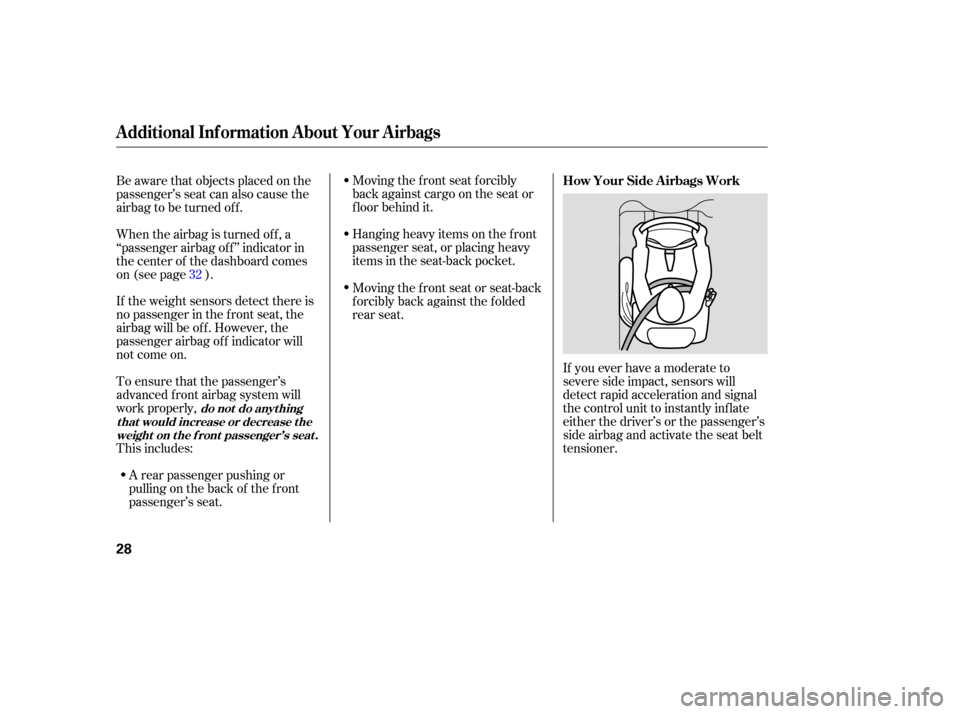
Moving the front seat forcibly
back against cargo on the seat or
floor behind it.
Hanging heavy items on the front
passenger seat, or placing heavy
items in the seat-back pocket.
If you ever have a moderate to
severe side impact, sensors will
de tect rapid accele ration and signal
the control unit to instantly inflate
either the driver’s or the passenger’s
side airbag and activate the seat belt
tensioner.
To
ensure that the passenger’s
advanced front airbag system will
work properly,
This includes:
If
the weight sensors detect there is
no passenger in the front seat, the
airbag will be off. However, the
passenger airbag off indicator will
not come on.
Wh
en the airbag is turned off, a
‘‘passenger airbag of f ’’ indicator in
the center of the dashboard comes
on (see page ). Be aware that objects placed on the
passenger’s seat can also cause the
airbag to be turned off.
A rear passenger pushing or
pulling on the back of the f ront
passenger’s seat. Moving the front seat or seat-back
f orcibly back against the f olded
rear seat.
32 How Your Side A irbags Work
do not do anyt hing
t hat would increase or decrease t he weight on the f ront passenger’s seat.
Additional Inf ormation About Your Airbags
28
Page 33 of 352

There will be some delay between
the moment the passenger moves
into or out of the airbag deployment
path andwhentheindicatorcomes
on or goes off.
A front seat passenger should not
use a cushion or other object as a
backrest. It may prevent the cutoff
system from working properly.
Only
one airbag will deploy during a
side impact. If the impact is on the
passenger’s side, the passenger’s
side airbag will deploy even if there
is no passenger.
To get the best protection from the
side airbags, front seat occupa nts
should wear their seat belts and sit
upright and well back in their seats.
Thesideairbagmayalsoshutoffifa
short adult leans sideways, or a
larger adult slouches and leans
sideways into the airbag’s
deployment path.
Objects placed on the front
passenger seat can also cause the
side airbag to be shut of f . If the side airbag of f indicator comes
on (see page ), have the
passenger sit upright. Once the
passenger is out of the airbag’s
deployment path, the system will
turn the airbag back on, and the
indicator will go out.
Your vehicle has a side airbag cutof f
system designed primarily to protect
a child riding in the f ront passenger’s
seat.
Although Honda does not encourage
children to ride in f ront, if sensors in
the seat detect a child has leaned
into the side airbag’s deployment
path, the airbag will shut off. 31
Side A irbag Cut of f Syst em
Additional Inf ormation About Your Airbags
Driver and Passenger Saf ety
29